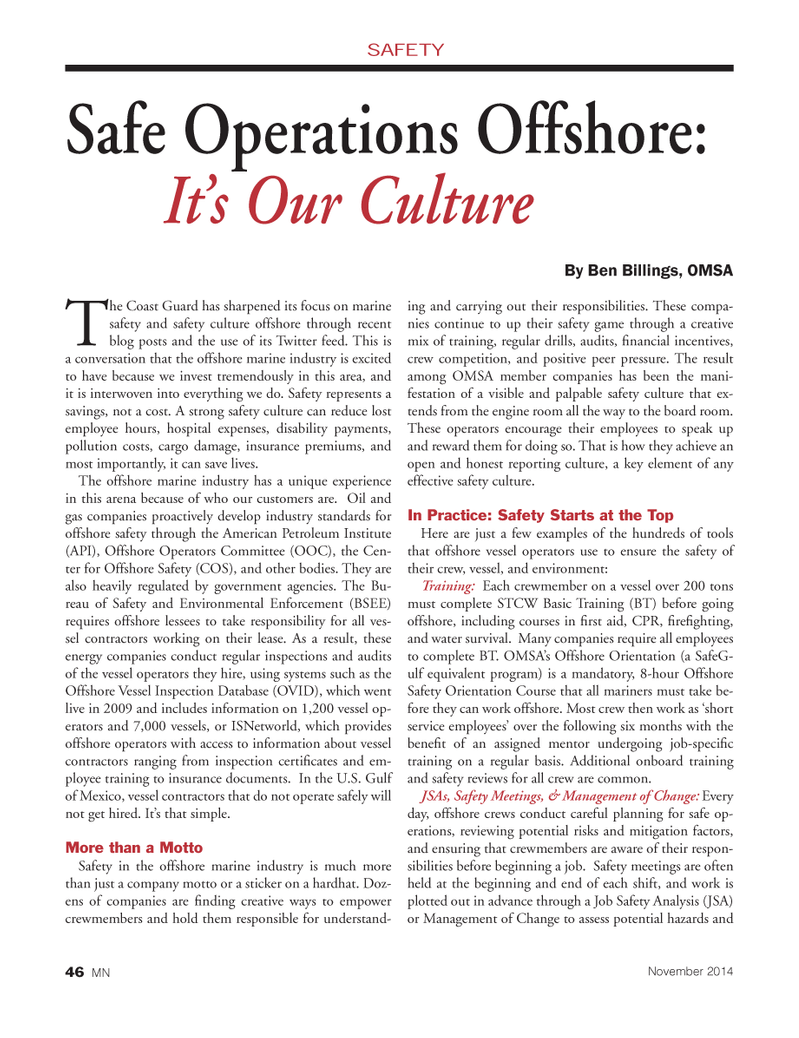
Page 46: of Marine News Magazine (November 2014)
Workboat Annual
Read this page in Pdf, Flash or Html5 edition of November 2014 Marine News Magazine
SAFETY
T he Coast Guard has sharpened its focus on marine safety and safety culture offshore through recent blog posts and the use of its Twitter feed. This is a conversation that the offshore marine industry is excited to have because we invest tremendously in this area, and it is interwoven into everything we do. Safety represents a savings, not a cost. A strong safety culture can reduce lost employee hours, hospital expenses, disability payments, pollution costs, cargo damage, insurance premiums, and most importantly, it can save lives.
The offshore marine industry has a unique experience in this arena because of who our customers are. Oil and gas companies proactively develop industry standards for offshore safety through the American Petroleum Institute (API), Offshore Operators Committee (OOC), the Cen- ter for Offshore Safety (COS), and other bodies. They are also heavily regulated by government agencies. The Bu- reau of Safety and Environmental Enforcement (BSEE) requires offshore lessees to take responsibility for all ves- sel contractors working on their lease. As a result, these energy companies conduct regular inspections and audits of the vessel operators they hire, using systems such as the
Offshore Vessel Inspection Database (OVID), which went live in 2009 and includes information on 1,200 vessel op- erators and 7,000 vessels, or ISNetworld, which provides offshore operators with access to information about vessel contractors ranging from inspection certifi cates and em- ployee training to insurance documents. In the U.S. Gulf of Mexico, vessel contractors that do not operate safely will not get hired. It’s that simple.
More than a Motto
Safety in the offshore marine industry is much more than just a company motto or a sticker on a hardhat. Doz- ens of companies are fi nding creative ways to empower crewmembers and hold them responsible for understand- ing and carrying out their responsibilities. These compa- nies continue to up their safety game through a creative mix of training, regular drills, audits, fi nancial incentives, crew competition, and positive peer pressure. The result among OMSA member companies has been the mani- festation of a visible and palpable safety culture that ex- tends from the engine room all the way to the board room.
These operators encourage their employees to speak up and reward them for doing so. That is how they achieve an open and honest reporting culture, a key element of any effective safety culture.
In Practice: Safety Starts at the Top
Here are just a few examples of the hundreds of tools that offshore vessel operators use to ensure the safety of their crew, vessel, and environment:
Training: Each crewmember on a vessel over 200 tons must complete STCW Basic Training (BT) before going offshore, including courses in fi rst aid, CPR, fi refi ghting, and water survival. Many companies require all employees to complete BT. OMSA’s Offshore Orientation (a SafeG- ulf equivalent program) is a mandatory, 8-hour Offshore
Safety Orientation Course that all mariners must take be- fore they can work offshore. Most crew then work as ‘short service employees’ over the following six months with the benefi t of an assigned mentor undergoing job-specifi c training on a regular basis. Additional onboard training and safety reviews for all crew are common.
JSAs, Safety Meetings, & Management of Change: Every day, offshore crews conduct careful planning for safe op- erations, reviewing potential risks and mitigation factors, and ensuring that crewmembers are aware of their respon- sibilities before beginning a job. Safety meetings are often held at the beginning and end of each shift, and work is plotted out in advance through a Job Safety Analysis (JSA) or Management of Change to assess potential hazards and
Safe Operations Offshore: It’s Our Culture
By Ben Billings, OMSA 46 MN
November 2014
MN Nov14 Layout 32-49.indd 46 10/23/2014 10:28:17 AM

 45
45

 47
47
